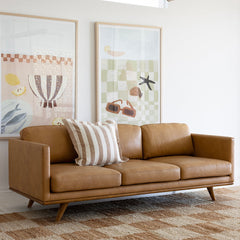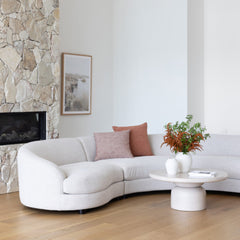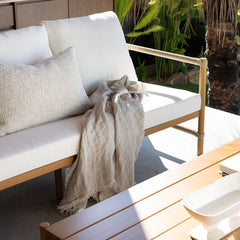How to Clean a Fabric Sofa in Australia: The Complete Step-by-Step Guide
Your fabric sofa is more than just a seat, it’s where you curl up with a good book, binge-watch your favourite series, or enjoy Sunday afternoon naps. It’s also where life happens, and life can be messy. Spilled coffee, muddy paw prints, crumbs from late-night snacks… they all find their way onto your couch.
Over time, dust, dirt, and stains can make your sofa look tired and smell less than fresh. The good news? You don’t have to call in a professional every time. With the right approach, you can clean your fabric sofa at home and bring it back to life without damaging the fabric or spending a fortune.
This guide will walk you through everything you need to know: from understanding fabric care codes and choosing the right cleaning method to tackling stubborn stains and keeping your sofa fresh year-round.

Step 1: Check the care label and fabric code
This is the most important step. Every sofa fabric behaves differently. Look for the manufacturer’s tag under a seat cushion or along the base. You will typically see one of these codes:
-
• W: Water-based cleaners are safe
-
• S: Solvent-based cleaners only, no water
-
• WS: Water or solvent are fine
- • X: Vacuum only, no liquids
Why this matters: using the wrong method can cause water rings, colour fade, texture changes, or even shrinkage. It can also void your warranty. If the tag is missing, proceed with caution. Always test your chosen cleaner on an inconspicuous spot and wait until it dries to confirm no discolouration.
Step 2: Gather your supplies
You probably own most of these already:
-
• Vacuum with upholstery attachment
-
• Soft-bristled brush
-
• White microfibre cloths or lint-free rags
-
• Mild dishwashing liquid
-
• Distilled white vinegar
-
• Baking soda
-
• Two bowls or buckets
-
• Spray bottle, optional
-
• A fan or access to fresh air for drying
If your current lounge is due for retirement, you can explore easy-care options in our luxury designer lounges and sofas collection.
Step 3: The 60-second spill rescue
When a spill happens, seconds count. Here is the quick save:
-
1. Blot, do not rub. Use a dry white cloth or paper towel to lift the liquid.
-
2. Work outside toward the centre so the stain does not spread.
-
3. Keep the area small. You can do the deeper clean once the emergency is contained.
This simple response often prevents a permanent mark and buys you time to set up properly.
Step 4: Prep the sofa
Dry soil removal makes everything easier. Vacuum slowly using short overlapping strokes. Lift cushions, get into seams, and use a crevice tool along the base and arms. If covers are removable and machine washable, check the tag. Cold gentle cycle, mild detergent, then air dry to avoid shrinkage. Never force-dry covers in a hot tumble dryer.
Step 5: Deodorise with baking soda
Baking soda is a safe, low-cost odour neutraliser that also draws out light oils.
-
• Sprinkle a light, even layer across the fabric
-
• Leave for 30 minutes, longer for strong odours
-
• Vacuum thoroughly
In humid parts of Australia, this step also helps absorb excess moisture that can lead to musty smells.

Step 6: Choose the right cleaning method by code
For W or WS fabrics
Mix a gentle DIY solution:
-
• 2 cups warm water
-
• 1 tablespoon mild dishwashing liquid
-
• 1 tablespoon white vinegar
Test on a hidden area first. Dip a microfibre cloth in the solution, wring it so it is damp not dripping, then blot the stain. Avoid flooding the fabric. When the mark lifts, rinse the area with a second cloth dampened with plain water, then blot dry.
For S fabrics
Use a solvent-based upholstery cleaner. Follow the product directions and ensure good ventilation. For oily stains, solvent is usually more effective. If you prefer a mild approach, try baking soda directly on the spot for 20 to 30 minutes, then vacuum.
For X fabrics
Vacuum only. Do not use water or solvent. For stains on X fabrics, call a professional.
Step 7: Stain solutions library
Here are targeted methods for the messes we all meet. Always test first.
Red wine
Blot immediately. Sprinkle table salt or bicarb to draw out pigment. Vacuum the granules, then use the W or WS solution above. Repeat if needed. Finish with a plain-water blot.
Coffee or tea
Blot while fresh. Clean with the W or WS solution. If the mark lingers, add a tiny pinch of bicarb to your cloth and gently blot again. Rinse with plain water.
Soft drink or juice
High in sugar, so they can get sticky. Blot, then use the W or WS solution. Rinse well so there is no residue that attracts dirt later.
Chocolate
Scrape off excess with a spoon, then treat with the W or WS solution. Cool water is helpful because heat can set cocoa fats.
Grease and takeaway oils
Sprinkle baking soda or cornflour, leave for 15 minutes, and vacuum. On W or WS fabrics, follow with a small drop of dish soap on a damp cloth. On S fabrics, move to a solvent cleaner.
Makeup and sunscreen
These often contain oils and pigments. For W or WS fabrics, try a tiny dot of dish soap in water and blot. For S fabrics, the solvent is safer. Work gently to avoid spreading colour.
Ink or texta
Use isopropyl alcohol on a cotton bud. Dab lightly and lift, do not rub. Follow with a plain-water blot. Take your time. Ink can spread quickly if you rush.
Mud
Let it dry fully, then vacuum or brush away the crumbs. Clean the faint mark that remains using the W or WS solution.
Grass
Treat like mud but sooner is better. A little white vinegar in the solution helps release green chlorophyll colour.
Blood
Cold water only. Blot with cold water first. If needed, add a drop of dish soap. Warm water sets proteins and makes the mark harder to remove.
Pet urine
Blot as much liquid as possible. Follow with an enzymatic cleaner that is safe for upholstery to neutralise odour crystals. Rinse lightly and dry fast to prevent smell from returning.
Vomit
Wear gloves. Scrape solids carefully, blot liquids, then clean with the W or WS solution. Finish with a mild disinfectant that is safe for fabrics, or an enzyme cleaner to remove proteins and odour.
Candle wax
Let it harden, then chip away gently with a credit card edge. Place a paper towel over the residue and apply warm, not hot, iron passes to lift remaining wax. Test first.
Water rings
These appear when the damp area dries with a hard edge. Lightly re-dampen the area with a clean, damp cloth and feather the moisture beyond the ring. Blot, then dry with a fan.
Unknown stain
Start with a dry approach. Vacuum, then baking soda. If you must wet clean and the code allows water, try the mild solution on a small section and stop if colour transfers.
Step 8: Optional deep clean of the whole sofa
For family lounges, pet-friendly homes, or after a run of spill-heavy gatherings, a periodic deep clean refreshes the entire sofa.
-
• For W or WS fabrics: use a steam cleaner with an upholstery tool or hire a Britex or Rug Doctor machine. Work in small sections, avoid overwetting, and follow with thorough extraction.
-
• For S or X fabrics: book a professional upholstery cleaner. Dry cleaning solvents and low-moisture methods require training and the right equipment.
- Deep cleaning is especially useful in coastal and tropical regions where humidity encourages odour and mould. It is also helpful after spring pollen season or a dusty renovation.
Step 9: Rinse, dry and groom
After spot cleaning or deep cleaning, remove residues and get the sofa dry quickly.
-
1. Rinse lightly with a cloth dampened in plain water if you use soap.
-
2. Blot with a dry towel to remove moisture.
-
3. Airflow is your friend. Open windows, run a fan, or use the air conditioner’s dry mode.
-
4. Groom the fabric once dry. A quick vacuum lifts the nap so the surface looks even again.
Never return cushions while they are damp. Moist foam can trap odour and encourage mould.
Australian-specific cleaning challenges
Australia throws a unique mix at our soft furnishings. Plan around these, and your sofa will last longer.
-
• Humidity and summer storms: High moisture can cause musty odours. Prioritise airflow and fast drying after any wet cleaning.
-
• Coastal salt air: Fine salt can sit on fabric and feel tacky. Weekly vacuuming and a light wipe of arms and headrests help.
-
• Dust and bush tracks: Rural or semi-rural homes see fine dust settle into seams. A slow vacuum with the crevice tool each week makes a big difference.
-
• Pollen season: Spring in many regions means extra dust and sneeze triggers. Increase vacuum frequency and wash throws more often.
-
• Pets: Many Aussie homes include dogs and cats. A lint roller or pet hair tool near the sofa keeps hair from embedding. Use a designated pet blanket over a favourite spot.
-
• UV exposure: Our sun is strong. Avoid placing fabric sofas in direct light. Rotate cushions and close curtains during peak hours to protect the colour.
Maintenance calendar
Print this simple plan and stick it inside your hall cupboard. It keeps the job small and manageable.
Weekly
-
• Vacuum cushions, arms, and seams
-
• Quick check for fresh spills to treat immediately
-
• Fluff and rotate loose cushions
Fortnightly
-
• Baking soda deodorises high-use areas
-
• Wash throws, swap pet blankets
Monthly
-
• Inspect for emerging stains on arms and seat fronts
-
• Wipe hard surfaces on the sofa frame or legs
Seasonally
-
• One thorough clean of contact areas, such as arm tops and headrests
-
• Move the sofa and vacuum underneath
Twice a year
-
• Deep clean W or WS fabrics
- • For S or X fabrics, schedule a professional service
Prevention that actually works
Small habits make the biggest difference.
-
• Throws and light covers: A washable throw on high-use zones takes the brunt of daily wear. Choose options that complement your look from our sofa cushions and styling pieces.
-
• Fabric protector: If your fabric is compatible, a quality protector creates a barrier that buys you time when spills happen. Reapply as directed.
-
• Set up a drinks tray: Giving glasses a stable home reduces sloshes.
-
• Pet routine: Keep a pet towel by the door for rainy walks. Guide pets onto their blanket on the lounge.
-
• Fresh air: A short daily window open can help keep odours down, especially in humid months.
- • Quick kit nearby: Keep a small caddy with microfibre cloths, baking soda, and a spray bottle with your W or WS solution under the sink so you do not delay treatment.
When to call a professional
Know your limits. Book a pro when:
-
• The fabric is S or X and the stain is significant
-
• You see repeated wicking where stains reappear after drying
-
• There is a strong odour after a pet accident or spill
-
• You suspect mould inside the cushions
-
• The sofa is due for a pre-sale refresh before renting or selling your home
Ask what method they will use, whether it suits your fabric code, and how they manage drying. A reputable cleaner will explain the risks and expected results.
Final Thought: When cleaning is no longer cost-effective
Even the best care has a limit. If the frame is sagging, the fabric is threadbare, or stains return quickly due to age, it may be time to replace it.
Ready to make sofa care easier? Pick a stain-smart base from our fabric sofas & lounges and contact us directly if you have any questions or need help with your purchase.





